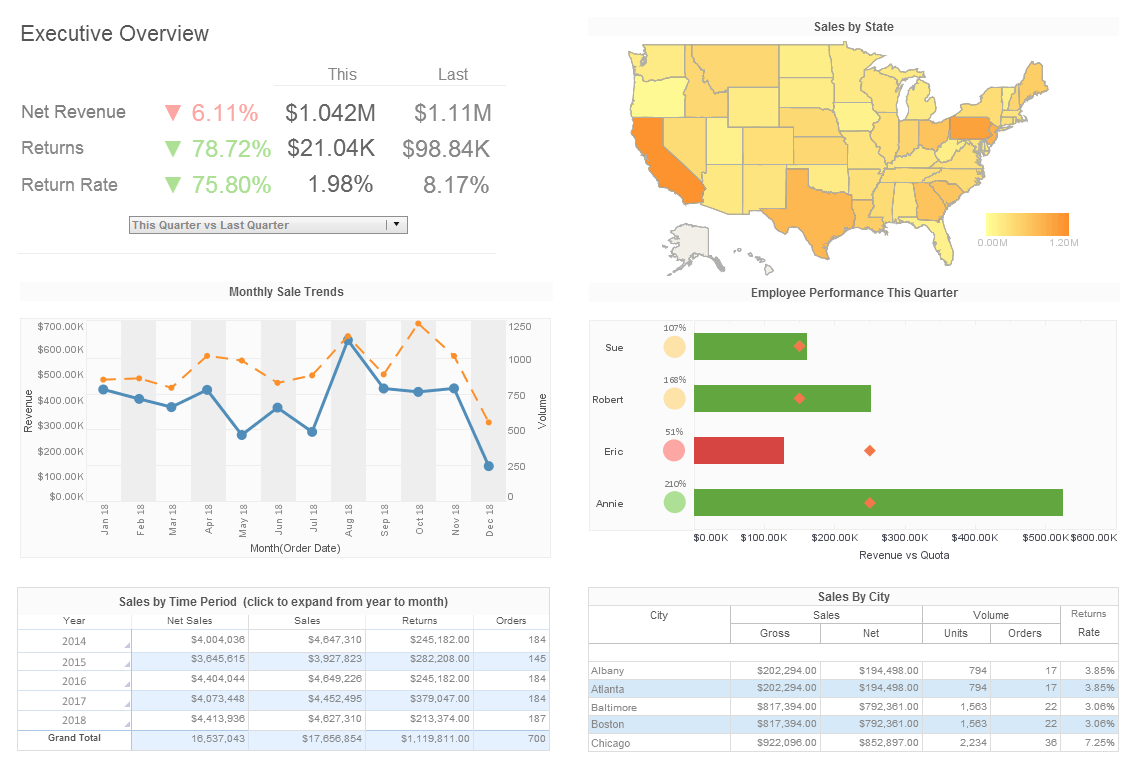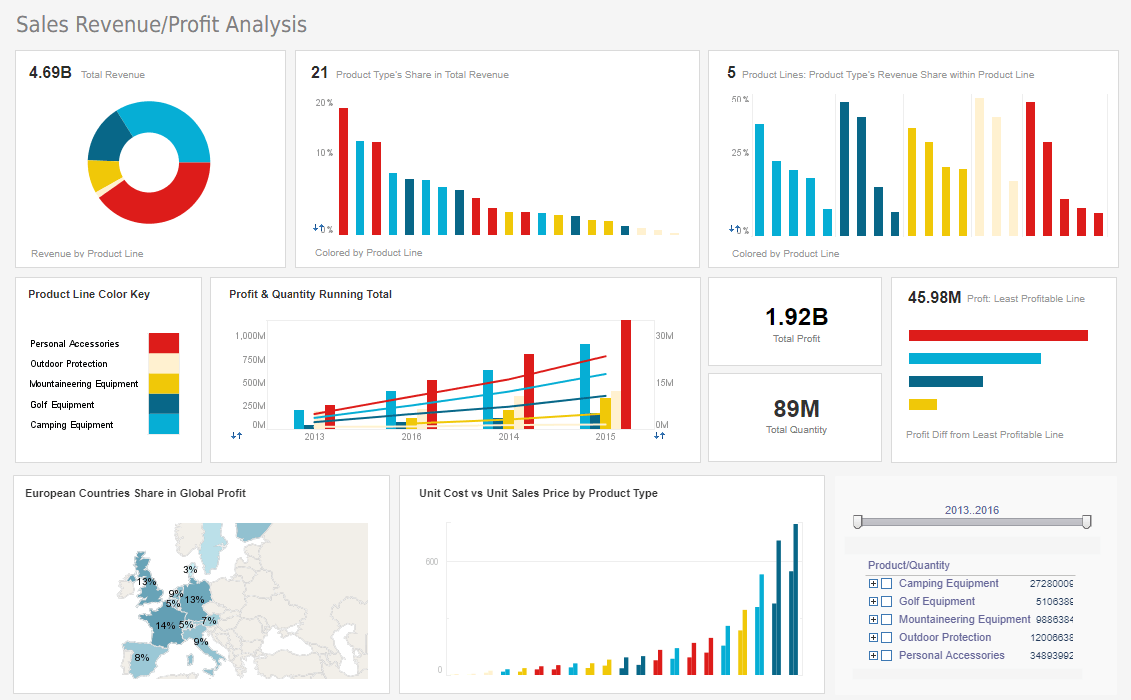BI Sales Reporting Tools
Are you searching for a way to monitor and analyze your sales data? A BI sales reporting tool will not only help you make sense of your past performance, but is also an excellent tool to help you predict future results as well.
InetSoft's BI sales reporting tool, StyleBI, helps you keep track of the actions of your workforce and compare them against your goals or previous performance. With this information, you can identify effective and ineffective strategies, and revise them accordingly.
Knowing where to focus your efforts becomes much easier when you have data behind your decisions. Additionally, your payroll and human resources departments rely of these numbers to calculate sales commissions, bonuses, and other compensation methods.

StyleBI for Sales Teams
Sales teams require up-to-the-minute information to do their job well. These individuals have quotas and it is important for them to know where they stand against company-wide goals and forecasts. Sales teams are crucial to the success of any organization with a product or service to sell.
StyleBI is prebuilt with a number of KPIs for sales with the goal of helping managers, directors, and sales representatives analyze their products, customers, regions, etc. A single view of this data can give an individual or a team of salespeople realistic goals to shoot for.
Visualizing the Results
By using the a simple drag-and-drop method , users can drag charts, data, filters, and other elements onto a canvas to visualize various metrics. Visualization is important, because it is really the only way to make real sense of the millions of rows of data produced by sales operations.
Data visualization translates raw data into a language we can understand. It reveals patterns and relationships that allow us to assess current and past performance, as well as predict future performance. Visualizations are key to crafting plans and strategies to reach business goals.

Powerful Data Access Engine
StyleBI enables you to convert huge stores of database information into an organized template for human consumption. Using our patent pending Data Block™ technology, business level end-users, those users with zero to no IT training, are able to perform complex queries and multidimensional data analysis.
Data pulled from your operational sales or CRM systems can be combined with almost any other data source, including: relational databases (JDBC), multidimensional databases, XML, SOAP, Java beans (POJO), EJB beans, flat files, Excel spreadsheets, OLAP cubes, salesforce.com, JDE, SAP, PeopleSoft, Siebel CRM, and more. Users simply drag and drop blocks of disparate data (hence, "data blocks') on to a spreadsheet like environment in order to analyze potential relationships that may not be immediately obvious. This is made easy through visualization.
About InetSoft
Since 1996 InetSoft has been delivering easy, agile, and robust business intelligence software that makes it possible for organizations and solution providers of all sizes to deploy or embed full-featured business intelligence solutions. Application highlights include visually-compelling and interactive dashboards that ensure greater end-user adoption plus pixel-perfect report generation, scheduling, and bursting.
InetSoft's patent pending Data Block™ technology enables productive reuse of queries and a unique capability for end-user defined data mashup. This capability combined with efficient information access enabled by InetSoft's visual analysis technologies allows maximum self-service that benefits the average business user, the IT administrator, and the developer. InetSoft solutions have been deployed at over 5,000 organizations worldwide, including 25% of Fortune 500 companies, spanning all types of industries.
What KPIs and Metrics Are Tracked and Analyzed in the Unmanned Aerial Vehicles (UAVs) Industry?
The Unmanned Aerial Vehicles (UAVs) industry, also known as the drone industry, relies on a variety of key performance indicators (KPIs) and metrics to track and analyze the performance, efficiency, and effectiveness of UAV operations. These metrics provide valuable insights into various aspects of UAV deployment, including safety, reliability, mission success, regulatory compliance, and financial performance. Let's explore some of the essential KPIs and metrics tracked and analyzed in the UAVs industry, along with their definitions and reasons for tracking:
-
Flight Hours: Flight hours refer to the total number of hours that UAVs spend in flight operations. Tracking flight hours provides insights into UAV utilization, maintenance requirements, and overall operational capacity. It helps in optimizing fleet management, scheduling maintenance, and assessing the return on investment (ROI) for UAV assets.
-
Mission Success Rate: Mission success rate measures the percentage of UAV missions completed successfully without incidents or disruptions. This KPI reflects the reliability, performance, and effectiveness of UAV operations in achieving their intended objectives, such as aerial surveys, inspections, or surveillance missions. A high mission success rate indicates operational efficiency and mission readiness.
-
Flight Range: Flight range quantifies the maximum distance that UAVs can travel from their launch point while maintaining communication and control links with ground operators. Monitoring flight range is essential for planning missions, ensuring coverage of target areas, and complying with airspace regulations. It also influences UAV design, payload capacity, and endurance capabilities.
-
Payload Capacity: Payload capacity measures the maximum weight that UAVs can carry in addition to their own weight, including cameras, sensors, and other mission-specific equipment. Tracking payload capacity is crucial for selecting appropriate UAV models for specific applications, optimizing payload configurations, and ensuring mission effectiveness and safety.
-
Battery Life: Battery life refers to the duration of time that UAVs can remain airborne on a single battery charge. Monitoring battery life is critical for planning flight operations, calculating mission endurance, and avoiding mid-flight battery failures or emergencies. It also drives advancements in battery technology and energy efficiency for UAVs.
-
Data Quality: Data quality assesses the accuracy, resolution, and reliability of data collected by UAV sensors, cameras, and other onboard equipment during flight operations. High-quality data is essential for making informed decisions, conducting analysis, and deriving actionable insights from UAV-generated data. Monitoring data quality ensures the effectiveness and value of UAV-based data acquisition.
-
Operational Efficiency: Operational efficiency metrics evaluate the cost-effectiveness and productivity of UAV operations, including factors such as fuel consumption, labor hours, equipment utilization, and mission turnaround time. Improving operational efficiency minimizes resource wastage, enhances profitability, and enables scalability in UAV deployment.
-
Regulatory Compliance: Regulatory compliance measures the extent to which UAV operations adhere to applicable laws, regulations, and licensing requirements imposed by aviation authorities and government agencies. Ensuring regulatory compliance is essential for avoiding legal penalties, liability risks, and operational disruptions. It involves compliance with airspace regulations, flight restrictions, privacy laws, and safety standards.
-
Safety Incidents: Safety incidents metrics track the frequency and severity of accidents, incidents, or near-misses involving UAVs during flight operations. Ensuring safety is paramount for protecting personnel, property, and the public, as well as maintaining public trust and confidence in UAV technology. Analyzing safety incidents helps in identifying root causes, implementing corrective measures, and enhancing safety protocols and training.
-
Customer Satisfaction: Customer satisfaction scores capture feedback from clients, stakeholders, or end-users regarding their experience with UAV services, including reliability, responsiveness, and quality of results. High customer satisfaction levels indicate strong performance, professionalism, and value delivery in UAV operations. Monitoring customer satisfaction helps in identifying areas for improvement, addressing customer needs, and fostering long-term relationships.
-
Return on Investment (ROI): Return on investment (ROI) measures the financial returns or benefits generated from UAV investments relative to the costs incurred. Calculating ROI involves comparing the gains or savings derived from UAV operations, such as reduced inspection costs, increased productivity, or improved decision-making, against the initial investment in UAV hardware, software, training, and maintenance. Positive ROI indicates the profitability and value proposition of UAV deployment.
-
Environmental Impact: Environmental impact metrics assess the ecological footprint and sustainability implications of UAV operations, including factors such as carbon emissions, noise pollution, habitat disturbance, and wildlife impacts. Minimizing environmental impact is essential for promoting responsible UAV use, mitigating ecological risks, and maintaining environmental stewardship. It involves adopting eco-friendly practices, optimizing flight routes, and adhering to environmental regulations.
-
Market Share: Market share measures the percentage of total market sales, revenue, or adoption held by a UAV manufacturer, service provider, or technology platform relative to competitors. Tracking market share helps in assessing competitive positioning, market trends, and industry dynamics. It also informs strategic decision-making, marketing strategies, and resource allocation for growth and expansion in the UAV market.
More Articles About BI Sales Reporting
Setting Group Numbering Using Report Scripting - To obtain the sequence number of an element within an expanding cell, use the '#' qualifier. (This is useful when you wish to add numbering to row/column headers.) For example, consider the formula table from the example in Referencing Cells in Summary Formulas. You will now add numbering for the expanding row header cell 'st'...
Highly Interpretable And Parsimonious - Most statistical methods are designed to be highly interpretable and parsimonious, whereas machine learning methods are designed to squeeze the most possible signals out of data. I like to put something in the definition of machine learning about systems that are making decisions automatically. Automation is a big part of machine learning. I would also say that is inherent. It is the loop that the algorithms can learn without manual intervention. We'll talk a little bit more about that when we get into more automation topics later on. I think we had a similar Tower of Babel 10 to 15 years ago when data mining was a hyped topic...
Tool to Make a Heat Map Online for Free - To easily and quickly create heat maps online for free, create a Free Individual Account on the InetSoft website. You will then be able to upload a spreadsheet data set...
Using a Radar Chart to Compare Multiple Product Measures - A radar chart, also known as a spider chart or star chart, is a type of chart used to display multivariate data in the form of a two-dimensional chart of three or more quantitative variables represented on axes starting from the same point. The data is plotted in the form of a polygon, with each vertex of the polygon representing one of the variables. This chart is often used to compare the values of multiple variables for a single data point...



